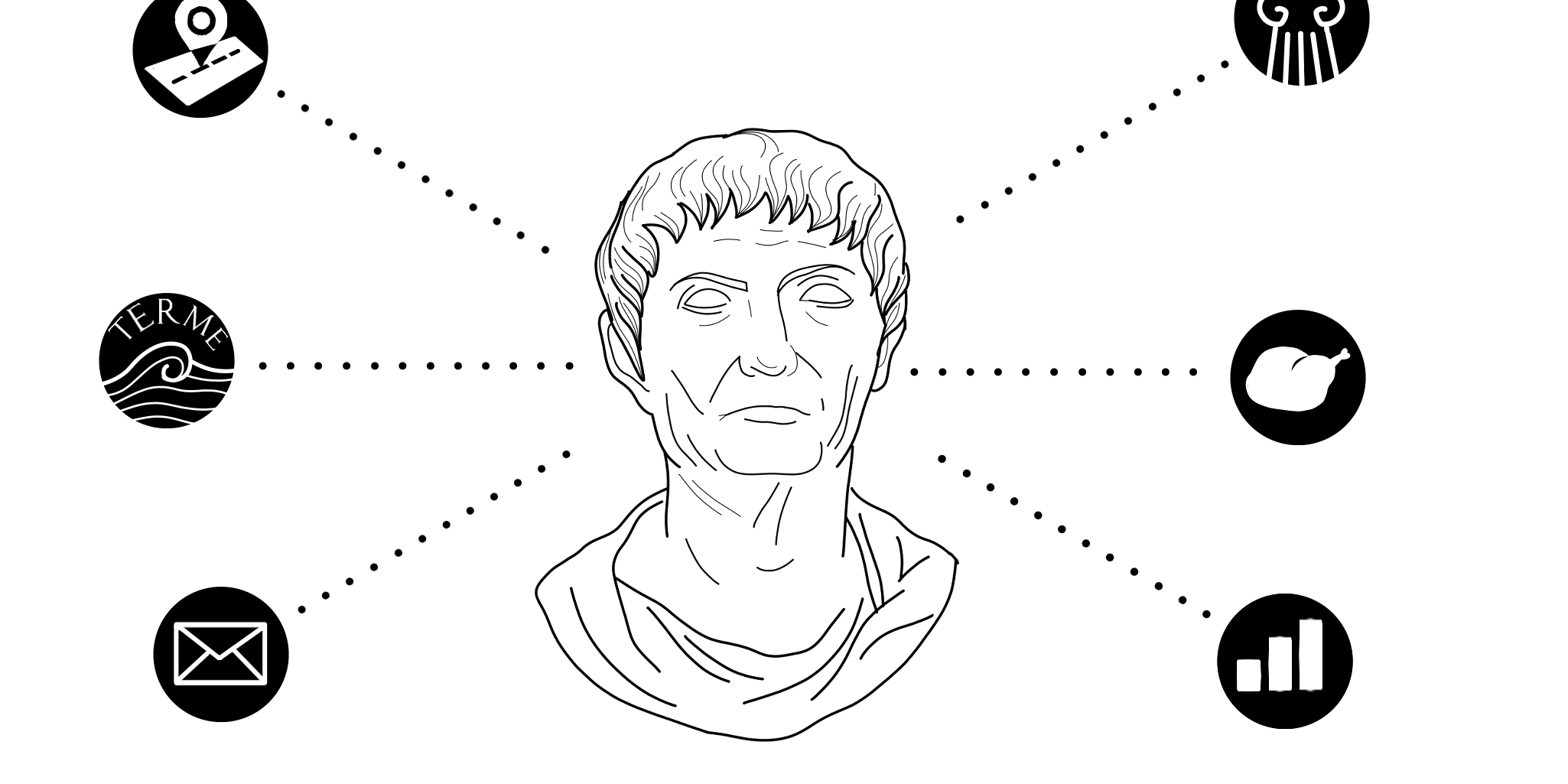For ENG, scroll.
Godina je 284. Nakon misteriozne smrti cara Numerijana, novim rimskim carem proglašava se Diokles, dotad glavni carski bodyguard – Dalmatinac je na vrhu svijeta (a nije Stipe Božić). U usporedbi s prethodnim razdobljem, tijekom kojeg se u 18 godina izredalo deset careva, dvadeset godina Dioklecijanove vladavine (prijestolja se odrekao 305.), obilježili su odlučna politika, uspješni vojni pohodi i reforme koje su, prema nekima, produljile život Carstva za više od stoljeća. Kako to sažima njegov biograf, a naš suvremenik, splitski publicist Jasen Boko, Dioklecijan se „odmah uhvatio posla“ te je u dvadeset godina uspio „ujediniti Carstvo pod čvrstom rukom, stabilizirati granice, formirati novi sustav vlasti, reorganizirati sustav vojske“, urediti „financijski, pravni i porezni sustav“ te „ostati upamćen kao jedan od najuspješnijih i najsposobnijih rimskih careva, koji bi vladao do smrti da nije sam odlučio učiniti presedan i odstupiti na vrhuncu slave.“[1]
Boko nam donosi fascinantan podatak: godine 290. Dioklecijan je „s velikom vojskom i cijelom logistikom prešao više od 7.000 kilometara od Panonije do Sirije, pa opet na zapad, do Milana, proveo najmanje dvije opsežne ratne operacije i pritom rješavao administrativne probleme u provincijama kojima je prolazio.“ Ne, na raspolaganju mu nisu bile „Đakovićeve“ Patrie, već 400.000 kilometara rimskih prometnica, od kojih je oko 100.000 km bilo popločano (mogli bismo reći, u statusu „autoceste“). Usporedbe radi, današnja Njemačka ima oko 640.000 km prometnica, Italija oko 490.000, Hrvatska 27.000 km. Glavne rimske magistrale dosezale su do sedam metara širine, otprilike koliko i suvremene državne ceste. Omogućavale su komunikacijski standard koji će, nakon propasti Carstva, ostati nezamisliv sve do druge polovice 18. stoljeća. Primjerice, u srednjovjekovnoj Dalmaciji pojam „velikog puta“ predstavlja cesta širine oko 2,3 metra. Nije puno grandioznija ni čuvena Karolina, prva od „strateških“ prometnica između Panonske nizine i Jadrana, izgrađena krajem 1720-ih. Nedugo nakon otvaranja, pokazalo se da je riječ o neprotočnom putu na kojem se nisu mogla mimoići ni dvoja kola. Ipak, dvorski se pjesnik nije dao smesti. Zapisao je: „Odlučnom je Karlu uspjelo, što nije ni slavnom Trajanu!“[2]
*
U vrijeme kad Dioklecijan stupa na povijesnu scenu, običnom su puku kola već dobrano krenula nizbrdo. Prosječni je Rimljanin živio na siru, vinu, nešto meda te ponekom kosanom odresku (samljeti se uvijek može svašta). No ponajprije – na pšeničnom kruhu. Smatra se da je odrasli muškarac konzumirao oko 900 g kruha dnevno (oko 40% potrošnje žita u obitelji). Iz jednog se modija (rimska mjera za žito, oko 7 kg) moglo ispeći dvadesetak štruca od oko pola kg, što je četveročlanoj obitelji moglo dostajati za pet do sedam dana. Rimsko zlatno doba (1. st. pr. Kr.-kraj 2. st.) podudara se s razdobljem tijekom kojeg je prosječna dnevna zarada iznosila oko 80% cijene jednog modija žita. Za oko dva mjeseca zaradilo se dovoljno za namirenje godišnjih potreba žita, što znači da su u ovom razdoblju prosječni Rimljani, kad se sve zbroji, na prehranu trošili možda oko polovice kućnog budžeta. Usporedbe radi, ovaj udio vrijedi u današnjem Trećem svijetu; u Hrvatskoj na hranu odlazi oko 30% kućnog proračuna; u najrazvijenijim zemljama, manje od 10%.
E sad, kako to već ide, svako „potrošačko društvo“ – a Rim je to u određenoj mjeri zacijelo bio – prije ili poslije dospije u bananu. Šezdesetak godina uoči stupanja Dioklecijana na vlast proteklo je u znaku brojnih nestabilnosti, upada barbarskih naroda i unutarnjeg slabljenja. Cijene su divljale. Zapustilo se tradicionalno moralno i političko-ekonomsko uvjerenje da žito nikad ne bi smjelo koštati više no što je „pošteno“ (danas izreku „kruha i igara“ doživljavamo u donekle nepravednom smislu, budući da u Rimu državne intervencije i donacije nisu bile samo demagoške naravi). Došlo je do masovnog osiromašenja.
U takvim je okolnostima, nakon otklanjanja vanjskih prijetnji, Dioklecijanov glavni priroritet bila ekonomska stabilizacija Carstva. Godine 301. izdan je Edikt o cijenama prodajne robe, tj. mnoštva proizvoda i usluga razvrstanih u ukupno 37 kategorija. Osim što je riječ o “jednom od najdužih i najvažnijih ikad pronađenih rimskih natpisa” (W. Kuhoff), Edikt je, prema Boki, „jedno od rijetkih svjedočanstava o Dioklecijanu kao čovjeku.“ U uvodu, između ostaloga, stoji i ovo:
“Kako neukrotiva mahnitost zna samo jednu žudnju: ne mariti ni za jednu zajedničku potrebu; kako je za bujanje pohlepe, u ognjici proždrljivih plamenova, gotovo sveta obveza – tako se misli među nemoralnima i besramnima – pri proždiranju svačijeg imutka zaustaviti se tek po nuždi, a ne vlastitom voljom; te kako se ne mogu više previđati svi oni koje je krajnja oskudica dovela do bivstvovanja u stravičnom stanju – dogovorili smo se, mi, skrbni roditelji ljudskog roda [misli se na tetrarhe, tj. Dioklecijana i tri suvladara koja je imenovao], da se kao prosuditeljica okolnosti angažira pravičnost…”
Osim što nije štedio na pohvalama onodobnom Wall Streetu, Edikt je u praktičnom pogledu nastojao stvari vratiti na staro (što je otprilike bila i ideja Dioklecijanova programa u cjelini). Zauzdavajući „podivljalu pohlepu“, Edikt o cijenama zapravo se obračunavao s inflacijom. Dok ga današnji liberali prokazuju ponajprije kao ogledni primjer štetnosti državnog interveniranja, riječ je o praktički prvom antičkom dokumentu koji, pod utjecajem kršćanskog umijeća apstraktnog mišljenja, uzroke ekonomskih kretanja ne traži samo u moralnim osobinama ljudi (poštenje, pohlepa, darežljivost itd.), nego i u ekonomskim silama izvan granica ponašanja pojedinca.
Iako je u zapadnjačku povijest unio nov način promišljanja ekonomskih kategorija, a u danom trenutku pokušao otkloniti problem koji je štetno djelovao na društvo, Edikt je neslavno propao. Zagovaratelji “ekonomskih sloboda” – ujedno i nositelji monopola na trgovinu robom široke potrošnje – istu su prestali isporučivati. Zavladali su još veća oskudica i crno tržište, pa se država odlučila povući. “Slobodno tržište” je spašeno.
***
It is the year 284 AD. After the mysterious death of Emperor Numerian, Diocles proclaimed himself the new Roman Emperor. The Dalmatian, who had up to then been the principal bodyguard, now stood at the top of the world. When compared to the previous period, in which ten emperors had succeeded each other in the span of 18 years, the two decades of Diocletian’s rule (he gave up the throne in 305) were marked by staunch political moves, successful military campaigns and reforms which, some believe, lengthened the life of the Empire for more than a century. This is summarized by his biographer, and our contemporary, the non-fiction author Jasen Boko. Diocletian, he says, immediately “rolled up his sleeves” and in twenty years managed to “unite the Empire under a strong leadership, stabilize the borders, form a new system of government, and reorganize the military”. He reordered the “financial, legal and tax systems”, and “was remembered as one of the most successful and capable Roman emperors, who would have ruled until his death had he not opted for a precedent and stepped down at the height of his glory.”
Boko shares a fascinating piece of information: In 290 AD, Diocletian traversed, “with a huge army and the accompanying logistics, more than 7,000 kilometres, from Pannonia to Syria and back west, to Milan. He undertook at least two extensive military operations and dealt with administrative problems in the provinces he visited.” No, he did not have the Jeeps, but 400,000 kilometres of Roman roads, out of which 10,000 were paved. (Call them “motorways”, if you like.) To compare, contemporary Germany has 640,000 kilometres of roads, Italy about 490,000, and Croatia 27,000. The main Roman highways were up to 7 metres in width, about the size of a modern state roads. They allowed for a communication standard which would, after the fall of the Empire, be hard to imagine until the second half of the 18th century. For example, a “large road” in medieval Dalmatia had the width of some 2.3 metres. The famous Karolina, built in late 1720s, which was the first “strategic” road connecting the Pannonian Basin (Karlovac) and the Adriatic coast (Bakar), was hardly any better. Shortly after its grand opening, the road revealed its deficiencies, as two vehicles could not pass each other by. The court poet remained staunch nonetheless and wrote, “The determined Charles has managed what eluded even the famous Trajan!”[3]
At the time when Diocletian steps onto the historical scene, the common folk had already had it worse for a while. An ordinary Roman subsided on cheese, wine, a little honey, and a “dunghill cock and Pentheus hash” (all manner of things can go into a hash). Primarily, however, a Roman subsided on wheat bread. It is believed that a grown-up man consumed about a kilo of bread a day (amounting to 40% of wheat-consumption in a family). One modius (the Roman wheat measure, of about 7 ) produced some twenty loaves of half a kilo each, which would have been the weekly supply for a family of four. The golden age of Rome (1st century BC to 2nd century AD) coincided with the period in which an average daily wage covered 80% of the price for a modius of wheat. It took two months to earn enough for the yearly supply of wheat, which means that an average Roman spent about half the household budget on food. In comparison, this percentage applies to the Third World countries of today. In Croatia, about 30% of budget is spent on food, while in the most developed countries it barely reaches 10%.
Every “consumer society” – and Rome qualified as such, in a sense – hits a dead end sooner or later. The sixty years prior to Diocletian’s rule had seen various instabilities, barbaric invasions, and weakening of the state from within. Prices rose unbridled. Down the drain went the traditional moral and political-economical belief that the price of wheat should never be “unfair”. (We are not always fair ourselves when considering the “bread and circuses” maxim, since interventions and donations by the Roman state were not of a purely demagogical nature.) Mass poverty reigned.
Under such circumstances, and having removed external threats, Diocletian made it his priority to economically stabilize the Empire. In 301 AD he issued the Edict on Maximum Prices, which included a multitude of products and services, classified into 37 categories. Apart from being “one of the longest and most important Roman inscriptions ever found” (W. Kuhoff), Boko claims that the Edict was “one of the rare testimonies to Diocletian’s humanity”. Among other things, the introduction to the document claims:
“But unmastered insanity has one desire: to have no soft spot for a necessity all share. Unprincipled and licentious persons think greed has a certain sort of obligation (greed that swells and roils with rapid fires), in ripping up the fortunes of all, to lose the need rather than the will to continue. They whom the extremes of poverty have forced to perceive their most miserable condition cannot strive farther. It is appropriate to the forethought of us who are the parents of the human race [meaning the tetrarchs, or Diocletian and his three designated co-rulers], that justice intervene in matters as a judge…”
Not sparing the praise for the contemporary , the decree attempted to reinstate some of the old practices. (This was a general idea of the entire Diocletian’s regime.). By bridling in the “ripping greed”, it tried to wrestle inflation. Modern-day liberals consider the decree primarily a case study for the harm that state intervention can make. It was, however, the first ancient document which, influenced by the Christian art of abstract thinking, tried to find the causes of economic changes not only in the moral characteristics of people (their honesty, greed, magnanimity), but also the economic forces outside the behaviour of individuals.
Although it brought to western history a new way of thinking about economics, and attempted to remove the problem which had dire consequences for the society of the time, the decree went bust. Those who advocated “economic freedoms” – and at the same time had the monopoly on the trade of consumer goods – stopped delivering them. Even greater scarcity ensued and the black marked developed, so the state decided to retreat. The “free market” was saved.
[1] Čitati Bokinu studiju je k’o vodu piti, stoga bacite oko na: Dioklecijan : Biografija kontroverznoga rimskog cara: reformator ili progonitelj kršćana?
[2] Misli se na austrijskog cara Karla VI. (1685.-1740.) te 1.600 godina starijeg rimskog cara Trajana (53.-117.).
[3] Meaning, the Austrian Emperor Carl VI (1685-1740) and his 1,600 years elder, Roman Emperor Trajan (53-117).
Illustrated by: Sanja Kolenko










